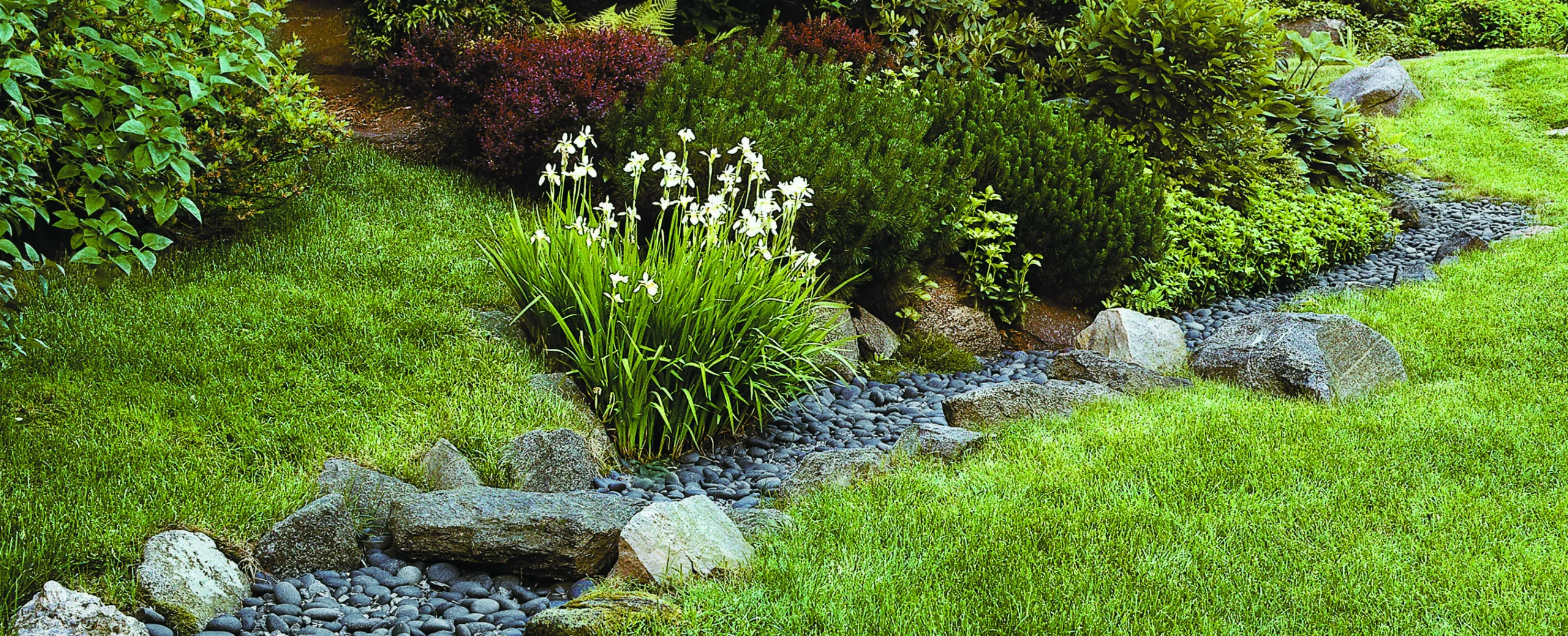Stormwater can wreak havoc on your property if not properly managed, creating issues such as soil erosion, flooding, and water pollution. To help you prevent problems, we’ll explore the best drainage systems for stormwater and explain how these systems work.
How Landscape Drainage Works
Stormwater management systems rely on water flow and absorption principles, using plants and soil for natural filtration and integrating existing landscape features.
Water Flow and Absorption Principles
Managing water flow is key to landscape drainage. This involves creating slopes to direct water and using absorbent materials to allow it to soak into the ground. Properly designed drainage systems ensure water is directed away from structures and absorbed efficiently.
The Role of Plants and Soil in Drainage
Plants’ roots help absorb water, and their foliage slows down water flow, allowing more time for absorption. Soil composition also impacts drainage—sandy soils drain quickly, while clay soils retain water longer.
Integration with Existing Landscape Features
Effective drainage systems should seamlessly integrate with existing landscape features. This could involve positioning swales along natural contours, using rain gardens to capture runoff from roofs, or incorporating pervious paving in driveways and walkways. Pervious pavement includes pervious concrete, porous asphalt, permeable paver blocks, and reinforced turf, and it allows water to pass through or around the material.
Types of Landscape Drainage Solutions
Several landscape drainage solutions exist, each with advantages and disadvantages. The most common solutions include swales, rain gardens, and pervious paving.
Swales, Rain Gardens, and Pervious Paving
Swales are shallow, vegetated channels designed to capture and convey stormwater. Rain gardens are depressions that allow rainwater to soak into the ground. Pervious paving includes porous concrete and permeable pavers that let water pass through.
Each drainage system has its pros and cons. Swales are relatively easy to install but may require regular maintenance. Rain gardens provide beauty and environmentally friendly benefits but can be labor-intensive. Pervious paving is durable and effective but tends to be more expensive.
Suitability for Different Landscapes
The best system for your home depends on various factors such as soil type, slope, and climate. Swales work well on gentle slopes, rain gardens thrive in areas with good drainage, and pervious paving is ideal for high-traffic areas.
Designing an Effective Swale System With Your Landscaping
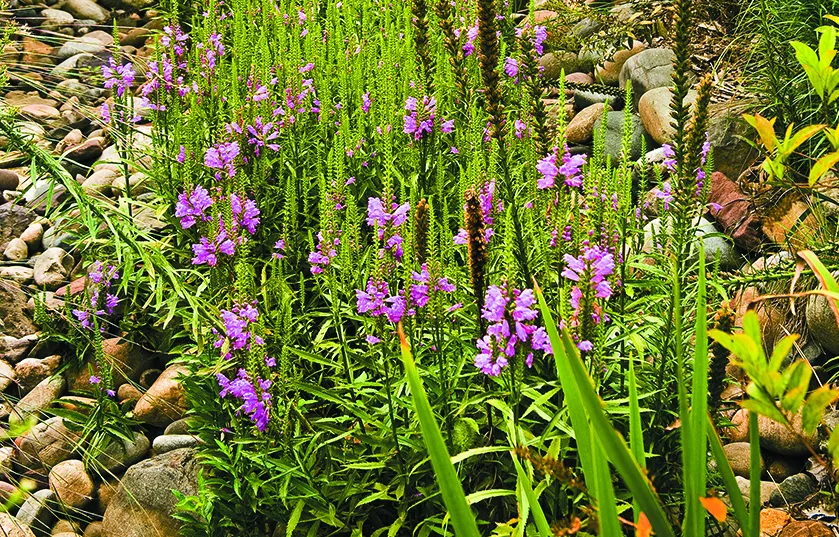
Designing a swale system involves calculating dimensions and slopes, selecting appropriate plants, and understanding the maintenance requirements. Swales are ideal for landscapes with mild slopes, providing an attractive yet efficient solution.
Calculating Dimensions and Slope
To design a swale, first calculate the appropriate dimensions and slope. The length, width, and depth of the swale will depend on the amount of water you need to manage and the slope of your landscape. Generally, a swale should have a gentle slope to facilitate water flow without causing erosion. If your property contains a septic system nearby, is situated near a cliff, or features a gradient exceeding 5%—a vertical drop of more than 1 foot over 20 feet horizontally—we recommend seeking professional advice from a landscape expert or civil engineer.
Plant Selection for Swales
Choose native plants that can tolerate both wet and dry conditions. Plant selection for swales varies based on specific zones:
- Uppermost region: Drought-resistant bushes such as Japanese sedge grass, ninebarks, and sweetbay magnolia
- Edges: Blooming perennials, including black-eyed susan, spiderworts, and coneflowers
- Core section: Moisture-loving native sedges and rushes
- Surrounding core: Flora tolerant of intermittent water pooling, like California aster and yellow monkeyflower
- Meadow habitat: Species that adapt to periodic inundation, such as comfrey, clovers, and most grasses
- Permanent or semipermanent water feature: Aquatic vegetation like sedges and reeds
Creating a Swale
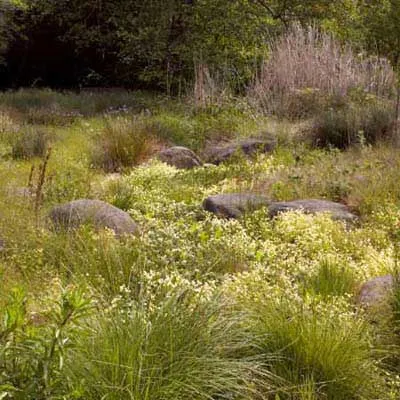
A swale should direct water to a safe absorption point, like a well-draining garden or dry well. Its sides should be three to four times wider than tall, which allows the first 8 inches of soil to drain efficiently. Loosening is recommended for fast-draining soil (at least 1/2 inch an hour). Slower soil needs 40% compost amendment, while very slow-draining areas require replacement with 60% sand and 40% compost. If the swale still can’t handle the water, excavate an additional 6-8 inches and then line the trench with filter fabric and perforated pipe. Top it off with 3/4-inch gravel and then 8 or more inches of compost-rich soil.
Creating a Functional Rain Garden
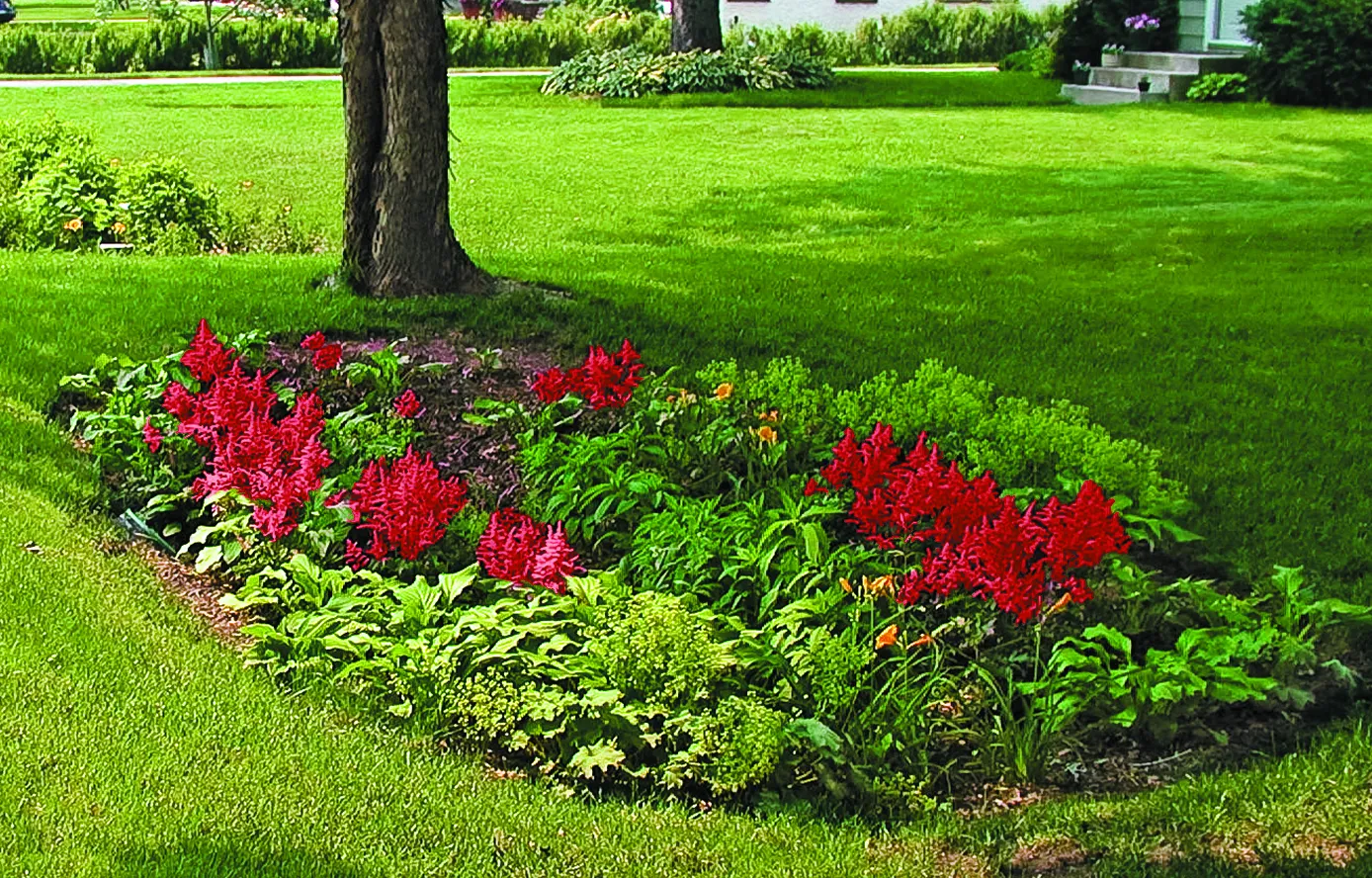
Rain gardens are an excellent option for capturing and absorbing stormwater. Creating a functional rain garden involves site selection, soil preparation, and choosing appropriate plants.
Rain gardens are appropriate drainage spots for steeper slopes than swales can handle, but where the surface drops more than 3 feet over a 15-foot horizontal distance, you should get professional design help. Although a low spot in the yard might seem an ideal placement, if it stays soggy, it’s already saturated. Instead, pick an area that dries out quickly.
Site Selection and Preparation
The first step is choosing the right site for your rain garden. Look for areas that naturally collect water, such as low spots in your yard. Be sure to select a location that drains rapidly, ensuring optimal water absorption and preventing oversaturation of the soil.
Once you’ve chosen a site, prepare the area by removing grass and compacting the soil. This will help the rain garden absorb water more effectively. We encourage you to seek expert design assistance for slopes that drop more than 3 feet over a 15-foot horizontal distance.
Soil Composition and Amendment Techniques
The soil should be well-draining to allow water to percolate. To improve drainage, you may need to amend the soil with organic matter or sand. Test the soil’s drainage capacity by observing how quickly water soaks in during rain.
Choosing Appropriate Plants for Different Zones
Select plants that are native to your region and can tolerate wet conditions. Divide the rain garden into different zones based on water levels: the base, the slopes, and the rim.
- Base: Water-loving plants like swamp milkweed, aster, and beebalm
- Slopes: Moderately water-tolerant plants like blue flag iris and dogwood shrubs
- Rim: Drought-tolerant plans such as coneflower, lavender, and salvia
Creating a Rain Garden
Creating a rain garden for roof or driveway runoff requires precise calculations, but you can start small and adjust based on storm performance. Position it at least 10 feet from your house and more than 40 feet from septic systems or steep slopes. For a 5-foot by 10-foot garden, consider professional excavation to create a 2-foot deep depression with gradual sides.
Amend soil as needed, aiming for a basin with 6 inches of ponding depth above 1–2 feet of improved soil. Plant water-tolerant species like native sedges and lady ferns in the center. Next, surround them with plants that withstand occasional standing water, such as redtwig dogwood. Use drought-tolerant native shrubs, both evergreen and deciduous, around the outer edges.
Anatomy of a Rain Garden
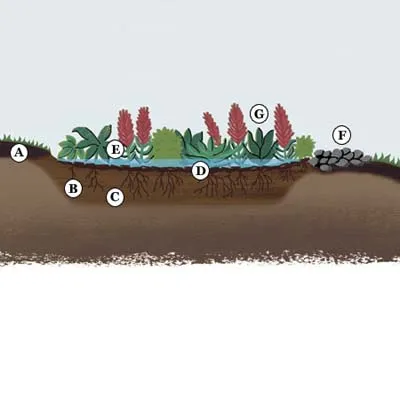
The figure above shows the basic components of a rain garden, with each letter noting these components:
A: Water flows in from slope, paved area, or pipe
B: Wide, shallow basin with flat, level bottom and gently sloped sides
C: 12–24 inches of fast-draining soil
D: 2 inches of mulch
E: 6 inches of ponding depth
F: Berm or stones to stem or slow down overflow
G: Perennial plants
Implementing Pervious Paving Drainage Solutions
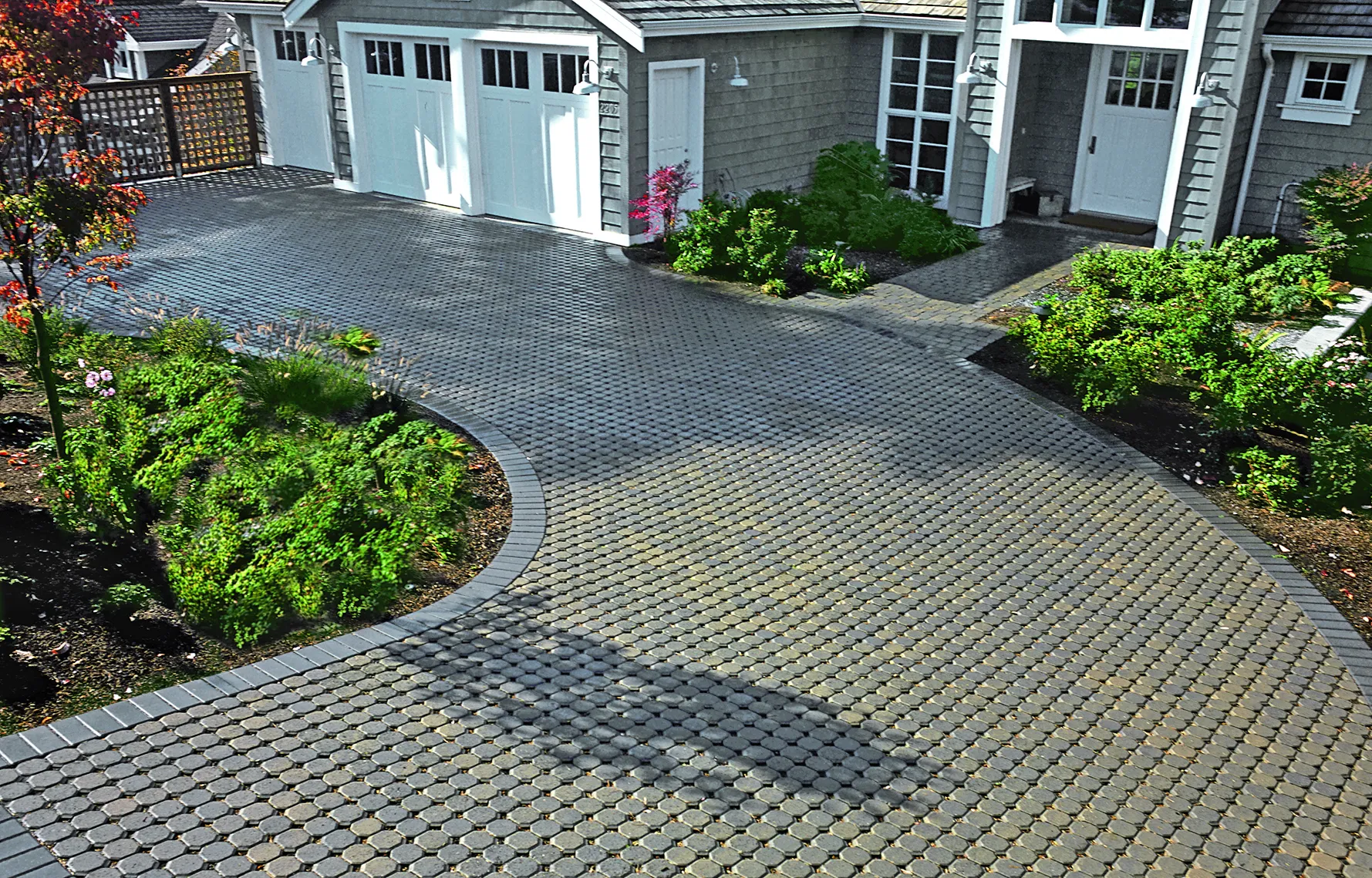
Pervious paving is a durable and effective solution for managing stormwater in high-traffic areas.
Types of Pervious Paving Materials

Several types of pervious paving materials are available. Options include porous concrete, permeable pavers, and plastic grid systems. Porous concrete allows water to pass through its porous structure, while permeable pavers feature gaps that let water infiltrate. Plastic grid systems use gravel or grass to create a permeable surface.
Installation Process and Considerations
The installation process for pervious paving varies depending on the material. Generally, it involves excavating the area, installing a base layer of gravel, and placing the pervious paving material.
Grid systems made of plastic are great for DIY installation. They need just 2–6 inches of gravel base, unlike other systems that require about 12 inches. This base can be compacted using a rented plate compactor. The grid material is easily unrolled and secured at the edges with pins. Fill the grid spaces with ornamental gravel or sand or add grass seed for a green finish.
While small-scale projects like walkways or patios using pavers or grid systems are suitable for DIY, driveways typically require professional intervention. Due to their complexity, specialized materials like pervious concrete and asphalt, which cost about 20% more than standard versions, invariably demand expert installation.
Anatomy of a Quick-Draining Driveway
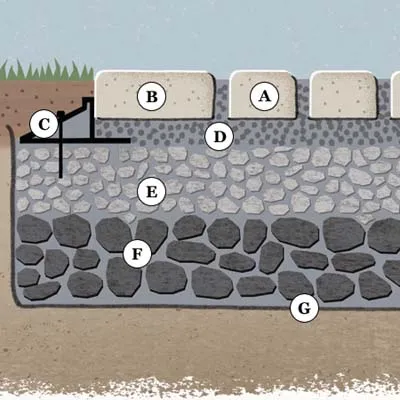
The figure above shows the basic components of a quick-draining driveway, with each letter noting these components:
A: Concrete pavers with spaces in between for gravel
B: Border paver (optional)
C: Edge restraint
D: 1 1/2 inches of 1/8- to 3/8-inch crushed gravel
E: 4 inches of 1/2- to 1 1/2-inch crushed stone extending 6 inches past drive to handle overflow
F: 4 to 5 inches of 2- to 3-inch crushed stone, as needed
G: Geotextile (optional)
Combining Multiple Drainage Systems
Combining different drainage systems can optimize stormwater management in complex landscapes. Integrating swales, rain gardens, and pervious paving can make your drainage strategy more effective.
This method involves strategic planning to ensure each system works together effectively. For example, you can direct water from a swale into a rain garden or use pervious paving to reduce runoff before it reaches other drainage features. This integration maximizes water absorption and minimizes runoff.
Environmental Impact of Stormwater Management
Effective stormwater management has a significant positive impact on the environment.
Benefits To Local Ecosystems
Properly managing stormwater supports local ecosystems by reducing the risk of flooding and erosion. It promotes healthy plant growth and provides habitats for wildlife. Well-designed drainage systems can create green spaces that enhance biodiversity.
Reduction of Pollution and Erosion
Proper stormwater management reduces pollution by filtering runoff through vegetation and soil. It prevents contaminants like fertilizers, pesticides, and oils from entering water bodies. Additionally, it reduces soil erosion by controlling water flow and stabilizing the soil with plants.
Water Conservation Aspects
Stormwater management systems promote water conservation by capturing and storing rainwater for later use. Rain gardens and swales help recharge groundwater, while pervious paving reduces the need for irrigation. These practices contribute to sustainable water management.
DIY vs. Professional Drainage System Installation
Do-it-yourself (DIY) draining solutions can be cost-effective and satisfying but require time, effort, and knowledge. Professional installation ensures expertise and quality results but costs more. Consider the scope of the project and your skill level when making a decision.
Skills and Tools Required for DIY
A DIY project require specific skills and tools. For example, you need to understand the principles of landscape drainage, calculate dimensions and slopes, and have tools like shovels, levels, and measuring tapes.
When To Consider Professional Help
Consider professional help for complex projects or if you lack the necessary skills and tools. Professionals bring expertise and experience and can handle large-scale installations and provide long-term maintenance plans.
Cost Considerations for Drainage Systems
The cost of drainage systems varies based on the project’s type, scale, and complexity. Swales are generally the least expensive, typically ranging from $5–$15 per linear foot.* Depending on plant selection and soil amendments, rain gardens can cost between $4 and $30 per square foot. Pervious paving is the most expensive, ranging from $8–$20 per square foot.
The quality of materials, labor, and additional elements like grading or soil amendment can also impact your price. Budget these factors to avoid surprises during the installation process.
*Cost data in this article sourced from contractor estimates used by Angi.
Our Conclusion
Whether you choose swales, rain gardens, pervious paving, or a combination of these systems to deal with stormwater, proper planning, design, and maintenance are key to success. Consider your landscape needs, budget, and skill level when deciding between DIY and professional installation. With the right approach, you can create a functional and sustainable drainage system that benefits you and the environment.
